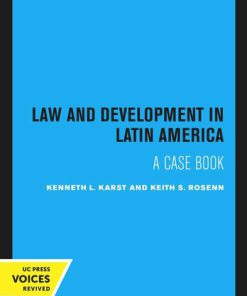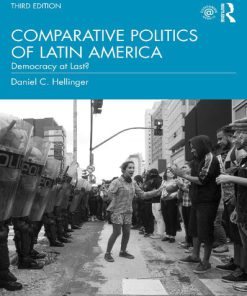Urban Mobility and Social Equity in Latin America 1st Edition by Daniel Oviedo, Natalia Villamizar Duarte, Ana Ardila Pinto ISBN 9781787690103 1787690105
$50.00 Original price was: $50.00.$25.00Current price is: $25.00.
Urban Mobility and Social Equity in Latin America 1st Edition by Daniel Oviedo, Natalia Villamizar Duarte, Ana Ardila Pinto – Ebook PDF Instant Download/Delivery: 9781787690103 ,1787690105
Full download Urban Mobility and Social Equity in Latin America 1st Edition after payment

Product details:
ISBN 10: 1787690105
ISBN 13: 9781787690103
Author: Daniel Oviedo, Natalia Villamizar Duarte, Ana Ardila Pinto
Urban Mobility and Social Equity in Latin America 1st Edition Table of contents:
Chapter 1-Should Urban Transport Become a Social Policy? Interrogating the Role of Accessibility in
1. Introduction
2. Accessibility as a Measure of Urban (in)equality
3. Bogotá and the Unequal Distribution of Accessibility
4. Reflections for Policy and Practice in Latin America
5. Conclusions
References
Chapter 2-Mobility and Gender Equity in Latin America: Different Mobile Burdens and Contributions in
1. Introduction
2. Conceptual Framework
3. Case Study
4. Data and Methods
5. Results
5.1 Gendered Mobility Patterns
5.2 Care Mobility
5.3 Activity-Based Approach: Men and Women’s Differential Itineraries
6. Conclusions
References
Chapter 3-Children and Urban Mobility: Care Dynamics on Family Mobility Patterns
1. Introduction
2. Mobility, Access and Gender
3. Methodology
4. Results
4.2. Mobility
4.2.1. Motivation
4.2.2. Mode of Transport
4.2.3. Ratio of Trips per Journey
5. Conclusion
References
Chapter 4-‘Like Sardines in a Can’. Gender, Stratification and Mobility in the Lives of Female H
1. Introduction
2. Household Labour, Space and Mobility
2.2 Space and Mobility
3. Bogotá’s Public Transportation System
4. Household Employees, Transportation and Socio-spatial Stratification in Bogotá
4.1 Work Schedules and Transportation
4.2 Means of Transportation
4.3 Spatial Segregation
4.4 Perceptions and Experiences of Safety
5. Conclusion
References
Appendix
Public Transportation System
General Mobility Statistics and Patterns
Interlocutors
Chapter 5-Sustainable Transport and Gender Equity: Insights from Santiago, Chile
1. Introduction: Gender and Equity in Sustainable Transport
2. Key Concepts and Methods: Gender and Transport ‘Justice’
3. What Origin–Destination Data Reveal about Women’s Travel in Santiago
3.1 Modal Share Evolution and Investment by Transport Mode
3.2 Poverty and Modal Share
3.3. Trip Purpose
4. Safety Perception and Sexual Harassment in Santiago’s Public Transport System
5. Discussion: Challenges and Opportunities for Sustainable Transport
References
3.1 The Ella se mueve segura survey in three Santiago districts
Chapter 6-Gendered Exploration of Emotive and Instrumental Well-being for Cyclist Woman in Latin Ame
1. Introduction
2. Why the Study is Centred in Woman Cyclists in Latin America
3. Why Cycling Should be Linked to Well-being?
4. Methodology
5. Analysis
5.1. Instrumental Factors
5.1.2. Care Role and Labour Market
5.1.3. Technical Skills
5.2. Emotive Factors
5.2.2. Freedom and Autonomy
5.2.3. Happiness
5.3. Social Factors
5.3.1. Bicimachismos
5.3.2. Socialisation with Others
5.3.3. Symbol of Democracy
6. Conclusions
References
Chapter 7-Active Commute to School, Physical Activity and Health of Hispanic High School Students in
1. Introduction
2. Hispanics in the United States
3. Physical Activity and Health: Racial and Ethnic Differences
4. Method
4.2. Data Source
4.3. Participants
4.4. Study Measures
5. Results
5.2. Race/Ethnicity Differences in Effects of Active Commuting and Other Physical Activity Behaviou
6. Discussion and Policy Recommendations
References
Chapter 8-Children’s Mobility and Playability in the Neighbourhood of Río Piedras: Perspectives f
1. Introduction
1.1 Children’s Mobility
1.2 Mobility Disadvantages of Children
1.3 The Importance of Playability of Children
2 Literature Review
2.2 Opportunities to Play in the City: Place, Access and Mobility
2.3 Social Disadvantages of Children’s Capability to Play Outside in the Neighbourhood
3. Children’s Playability Examined: Method
3.1 Study Area
4. Findings
4.1 Perception of Crime in a Poor Neighbourhood: Worse Than Presence of Cars for Supporting Childre
4.2 The Street Saves the Day: Children Subvert Time and Space Structure in Favour of Greater Playab
4.3 Time-Structured and Place-Determined ‘Play’ in the Neighbourhood
4. Discussion
5. Conclusion
References
Chapter 9-Mobility and equity: the problem of access to city spaces by individuals submitted to psy
1. Introduction
2. Theoretical Discussion
3. Research Problem
4. Methodology
5. Results and Discussion
5.2. Mobility and Access in Residential Therapeutic Services
6. Final Considerations
References
Chapter 10-Urban Accessibility in Belo Horizonte, Brazil: A Case Study of Mobility Practices and Dem
1. Introduction
2. Literature Review
3. Frameworks and Methods
3.1. Conceptual Framework
3.2. Data Collection and Systematisation
4. Results
4.1. Daily Travelling Practices of People with Disabilities
4.2. Mobility Experiences of People with Disabilities in Belo Horizonte
5. Final Considerations
References
Epilogue-Urban Mobility and Social Equity in Latin American Cities: Evidence, Concepts and Methods f
Index
People also search for Urban Mobility and Social Equity in Latin America 1st Edition:
black mobility inc
social mobility united states
urban mobility meaning
urban mobility examples
mobility in america
Tags: Daniel Oviedo, Natalia Villamizar Duarte, Ana Ardila Pinto, Urban Mobility, Social Equity, Latin America
You may also like…
Education Studies & Teaching - Studying & Test Preparation
History - Latin American History
Visualizing Loss in Latin America Biopolitics Waste and the Urban Environment Gisela Heffes
Uncategorized
Engineering - Civil & Structural Engineering
Planning and Design for Sustainable Urban Mobility 1st Edition Un-Habitat
Uncategorized
Politics & Philosophy - Politics
Comparative Politics of Latin America Democracy at Last 3rd Edition Daniel C. Hellinger
Hobbies & Games - Other Sports
Performance Analysis in Game Sports Concepts and Methods Concepts and Methods Martin Lames
Politics & Philosophy - Women's Studies











